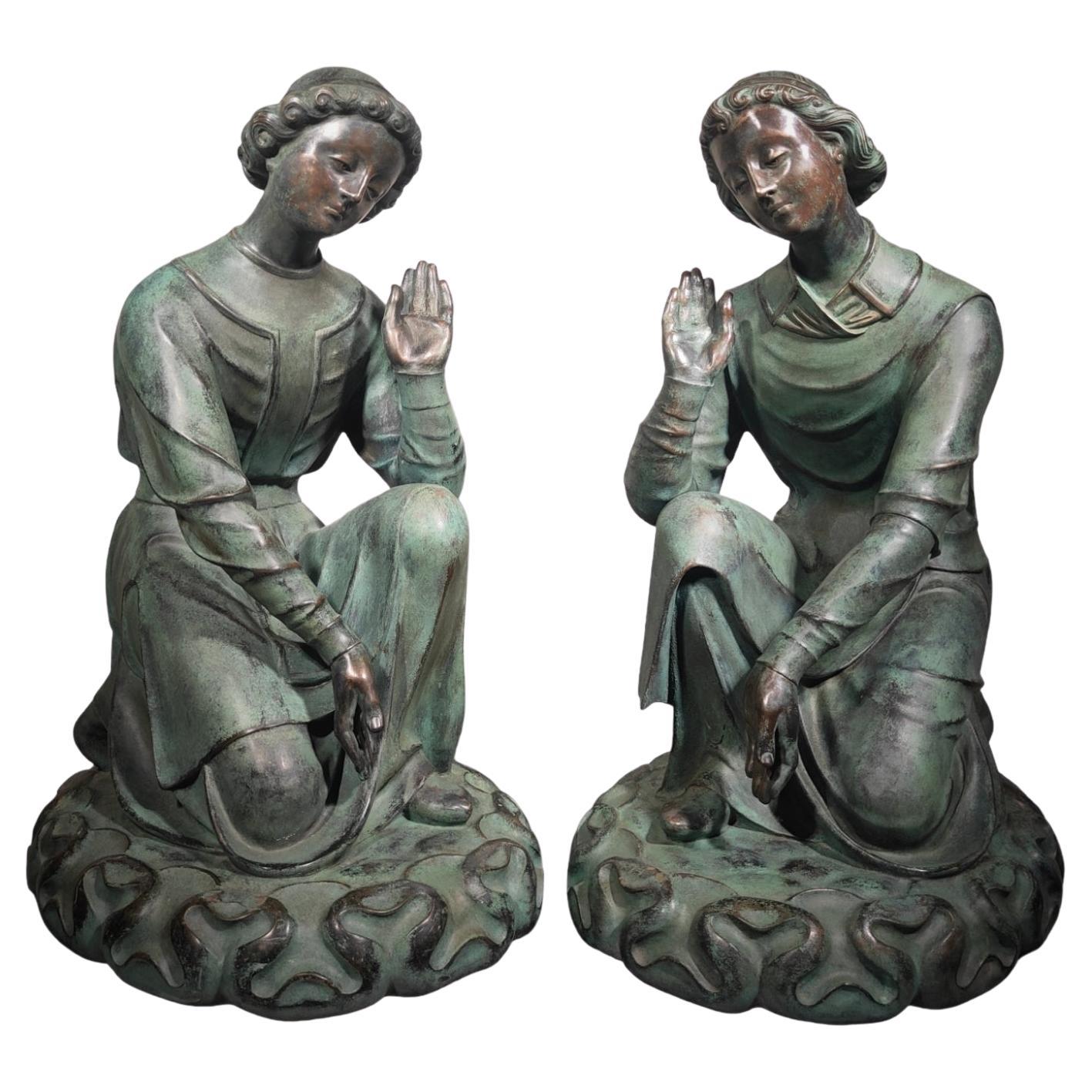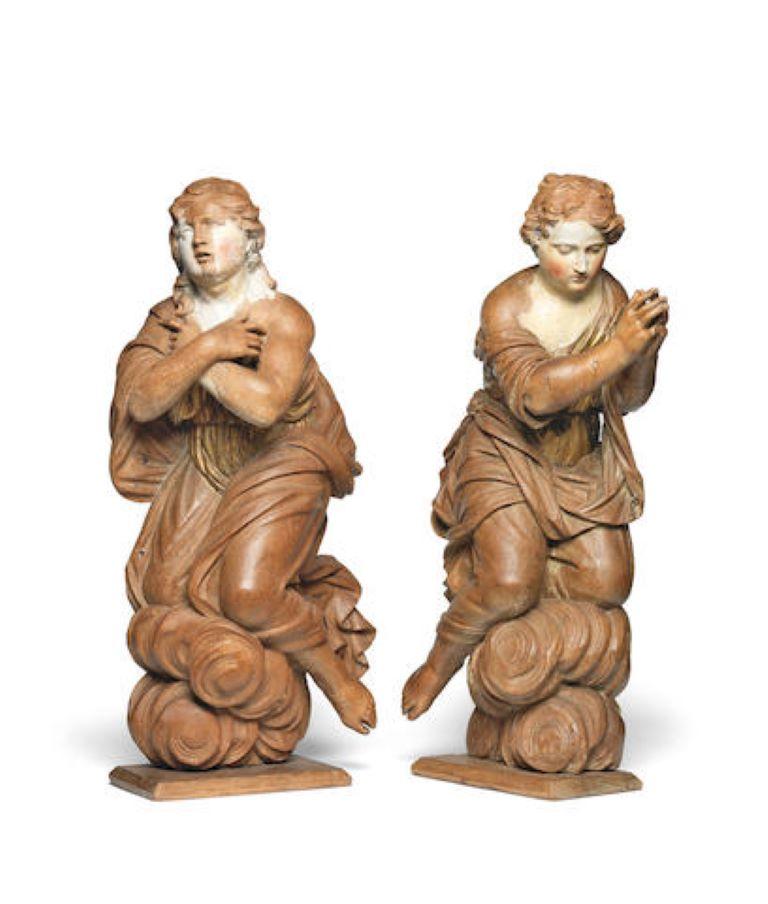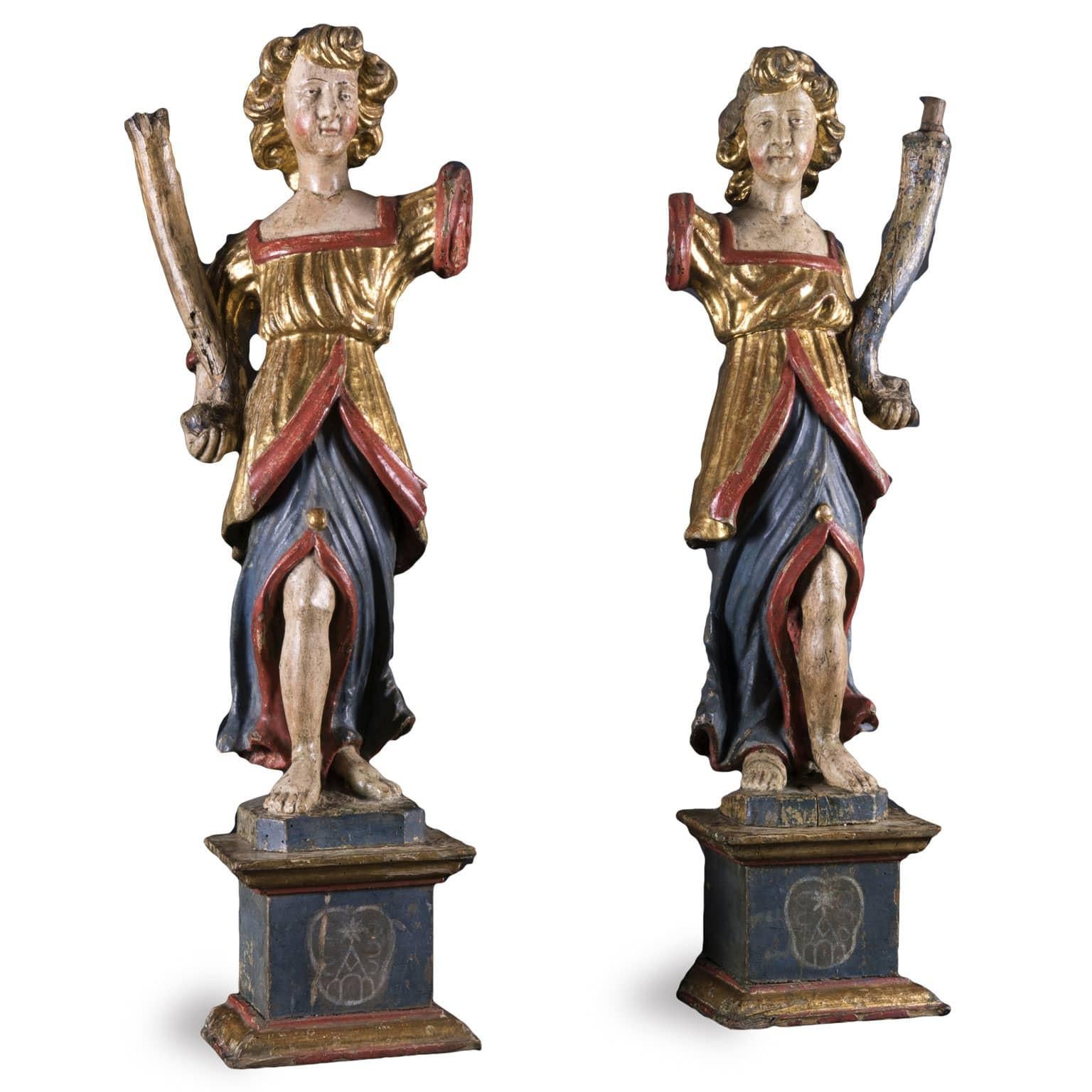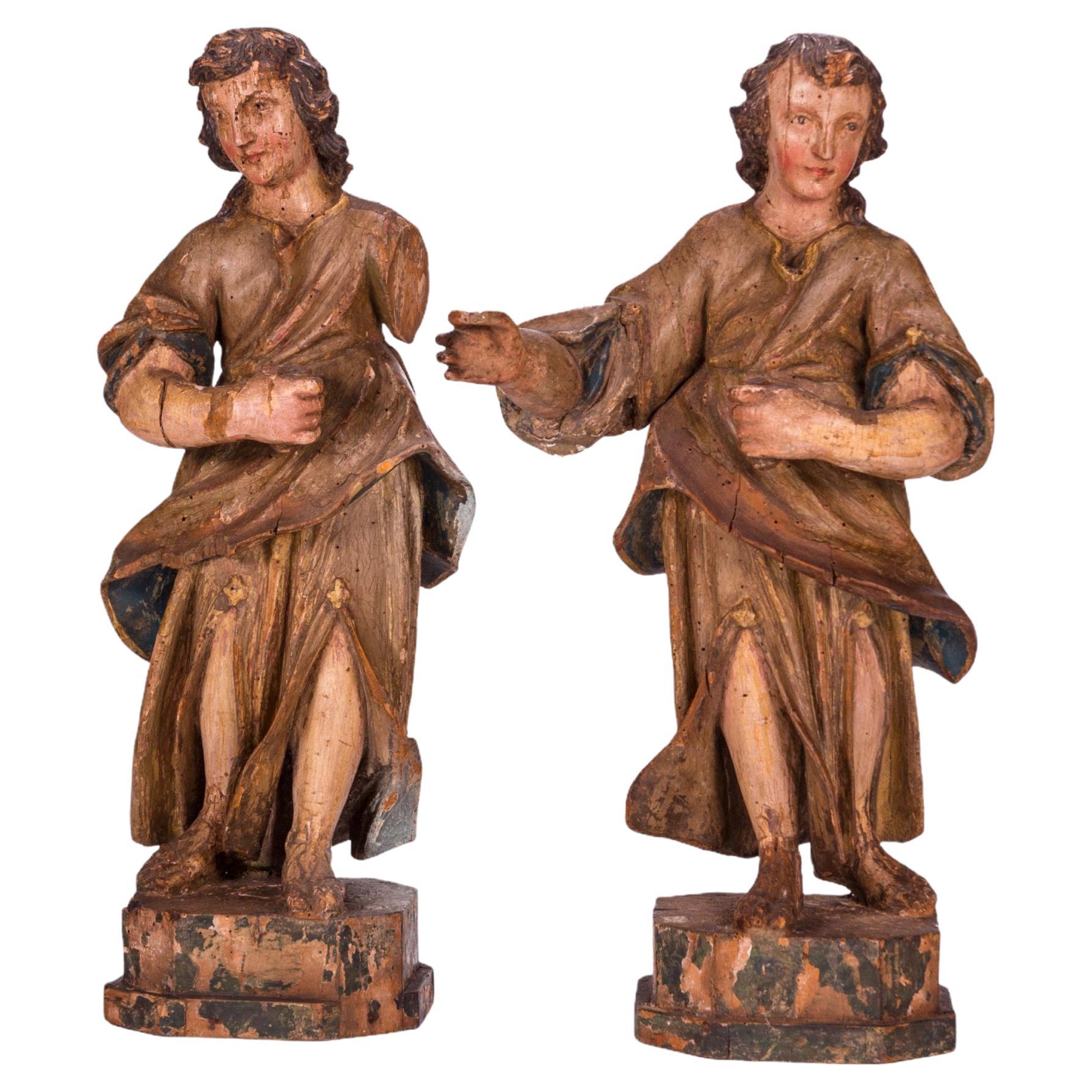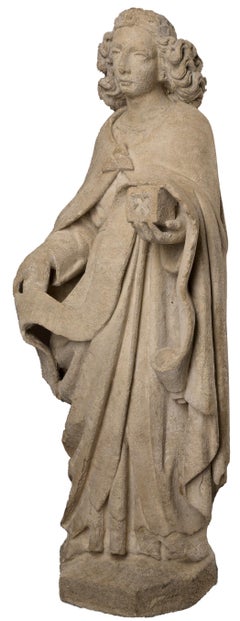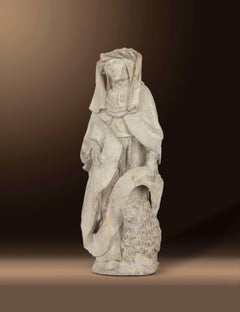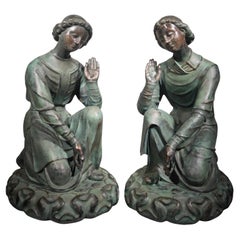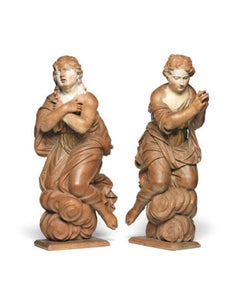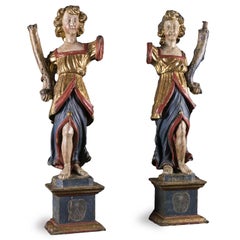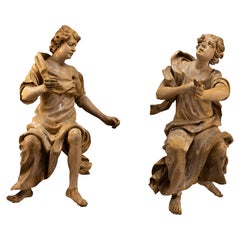Items Similar to Pair Flying Angels
Want more images or videos?
Request additional images or videos from the seller
1 of 7
UnknownPair Flying Angels1500
1500
$38,000
£28,926.36
€33,344.88
CA$54,116.63
A$59,023.57
CHF 31,032.19
MX$713,990.67
NOK 387,242.94
SEK 365,907.77
DKK 248,944.55
About the Item
MUSEUM PAIR FLYING ANGELS
Brabant/Brussels
Around 1500
Oak wood, full round carved
Height 40/38 cm
These two figures are a pair of flying angels made around 1500 in the province of Brabant in Flanders. They are carved from oak wood and have dimensions 38-40 cm. The angels can be attributed to the circle of Jan Borman the Elder, an important Flemish carving master of the late Gothic period or the Dutch Renaissance, who was active in Brussels between 1479 and 1520. He was the founder of a Brabant sculptor dynasty and joined a sculptor’s guild in Brussels in 1479. The reference work of this sculptor family is considered to be the Saint George retable for the chapel Onze-Lieve-Vrouw van Ginderbuyten in Leuven, which he possibly executed together with his son Jan Bormann the Younger in 1493. In 1511 he was also commissioned to make wooden models for the tombs for the Duke and Duchess of Brabant.
The angels are shown in elongated-manicured, moving form; the bent legs and swirled robe reveal that the angels are probably in flight. The slits of the separately carved and later attached wings are clearly visible on the backs of the full-round figures. Particularly impressive is the richly decorated clothing with variously decorated tops with ornate textile surfaces. Typical for carvings from Brabant are here also the long, tubular folds of the drapery. Particularly characteristic, however, are the short, almost weightless, luxuriant locks of hair, parted at the center parting and ending in two small curls above the forehead. This expression is comparable to a figure in the Arenberg Lament of 1470-80 (Detroit Institute of Arts, inv. no. 61,164) or the candelabra angels of about 1500 (Detroit Institute of Arts, inv. no. 25,18-19). Other comparative examples are in the Cleveland Museum of Art (inv. no. 1948.475) and in a 2019 Sotheby’s auction (lot 21), the latter figure of an angel having a similar head of hair as well as the same slit-like openings on the back where originally attached wings must have been. However, the angels presented here are far more richly decorated, as is often seen in the carvings of Jan Borman. His style is particularly associated with carefully carved decorative details of contemporary costumes and elaborate hair, as well as dynamic poses.
The level-headed faces with almond-shaped eyes, straight noses and small mouths are turned downward, probably looking down at the viewer. The faces, which seem almost individual, testify to a lifelike expression of expressive piety, which is emphasized by the hands folded in prayer. Through this, the heavenly creatures show the believers what attitude they should take. Since the 15. century the demand for altars for private devotion increased, it could be here figures of an altar for a representative house chapel. Very related in this context is from the Brussels carved altar from the beginning of the 16th century from the Museum Schnütgen in Cologne. This is an extremely rare opportunity to acquire a work from the circle of this important dynasty of sculptors and at the same time two figures in museum quality execution of the Dutch Renaissance.
- Creation Year:1500
- Dimensions:Height: 15.75 in (40 cm)Width: 8.67 in (22 cm)
- Medium:
- Period:
- Condition:Very good Condition.
- Gallery Location:Wien, AT
- Reference Number:1stDibs: LU1143210963392
About the Seller
No Reviews Yet
Vetted Professional Seller
Every seller passes strict standards for authenticity and reliability
Established in 1986
1stDibs seller since 2019
- ShippingRetrieving quote...Shipping from: Wien, Austria
- Return Policy
Authenticity Guarantee
In the unlikely event there’s an issue with an item’s authenticity, contact us within 1 year for a full refund. DetailsMoney-Back Guarantee
If your item is not as described, is damaged in transit, or does not arrive, contact us within 7 days for a full refund. Details24-Hour Cancellation
You have a 24-hour grace period in which to reconsider your purchase, with no questions asked.Vetted Professional Sellers
Our world-class sellers must adhere to strict standards for service and quality, maintaining the integrity of our listings.Price-Match Guarantee
If you find that a seller listed the same item for a lower price elsewhere, we’ll match it.Trusted Global Delivery
Our best-in-class carrier network provides specialized shipping options worldwide, including custom delivery.More From This Seller
View AllMaster Angel
Located in Wien, Wien
MASTER ANGEL
Museum sculpture of the master of Mauer
Austrian Danube Region
Around 1500/20
Lime wood, carved full round
Height 55 cm
Provenance:
Hofstätter Collection, Vienna
The masterful sculpture was made in the workshop of the master of the altar of Mauer around 1500 in Lower Austria. It can be located in the context of the Danube school of the first third of the 16th century, was carved from limewood and is 55 cm tall. Since there are no attributes or context, it is an unknown figure of a carved altar.
The master of the altar of Mauer is an anonymous Gothic carver who was active between 1500 and 1525 and received this so-called emergency name through the altar for the parish and pilgrimage church of Mauer near Melk. This winged altar was probably commissioned by Göttweig Abbey in the 1470s and is made of lime wood. It shows an expression in the transition from late Gothic to early Renaissance and is considered the most important carved altar in Lower Austria, created between 1510-15.
The figure presented here is very related in its design to the figures of the altar of Mauer. In lively-moving form, the male figure turns his upper body to the right, with his head pointing upward, probably toward the sky. The right leg in lunge emerges from under the frock...
Category
16th Century Figurative Sculptures
Materials
Wood
Apostel group
Located in Wien, Wien
APOSTLE GROUP
ORIGINAL VERSION
Flemish/Brabant
Around 1500
Oak wood carved
Height 37.5 cm, width 12 cm,
Depth 12.5 cm
Category
15th Century and Earlier Figurative Sculptures
Materials
Wood
$19,800
Standing Engel
Located in Wien, Wien
Standing angel with banner
Flemish
Around 1450/60
Sandstone
60 x 21 x 15 cm
This museum figurine shows a standing angel with a banner in his right hand and a small box in his left. The youthful, ageless figure wears a coat held together with a triangular, floral brooch in front of the chest over a long robe. The angel’s gaze is directed forward, his head tilted slightly to the left. The elongated face is sculpted: the large almond-shaped eyes with accentuated upper and lower eyelids are alertly open and sharp eyebrows lead directly into the root of the nose. The straight nose above the pronounced mouth completes the idealized oval face of the angel and his calm, internalized facial expression. What is particularly remarkable, however, is the magnificent curls, which are only partially tamed by a simple headband. As if puffed up by the wind, the hair, which is sometimes streaked in parallel, sometimes wildly twisted and richly curled, stands out dynamically from the ears. The tilted head with these sideways protruding waves of hair thus conveys an immediate impression of movement. The physicality of the sculpture is expressed particularly through this organic, lifelike movement of the loosened hair.
The lively overall impression of the figure is further enhanced by the multiple rolled banners that the angel presents to the viewer. The outstretched palm of the right hand appears both intimate and confidential as well as mystically revealing. This banderole winds in gentle curves in front of the figure’s body, throws a fold over the second attribute in the angel’s left hand and falls downwards in a loose manner. The volute-shaped rolled up end of the banner clearly shows the fine texture of the banner and at the same time draws the viewer’s attention to the small cube-shaped box that the angel is holding in its slender, long-limbed fingers. The cube is decorated with a Gothic quatrefoil motif, which is often seen in the architectural tracery of windows, but was also often used to decorate caskets and other small treasures. The sweeping gestures in the presentation of the attributes suggest three-dimensionality, in contrast to the tubular folds at the base of the neck and the intricate draperies in flat and multiple overlapping garment sections. The soft curves of the folds give the impression that the clothing is made of a heavy fabric that falls diagonally down the front and is laid in several bowl folds under the right hand.
Overall, the sculptural work testifies to the highest artistic skill, which emphasizes the virtuosity of sculpture in its precious and representative overall impression. The memorable characteristics recognizable here can be seen in comparable pictorial works from Utrecht around the middle of the 15th century, when sculptural art – especially stone sculpture – was characterized by a remarkably high quality. Particularly noteworthy is the accentuated Utrecht head type with an elongated oval face, almond-shaped eyes with heavy lids and dense, vividly protruding tufts of hair framing the head. For example, the figure is comparable to a capital of an angel on the east side of the rood screen of the Joriskerk in Amersfoort (province of Utrecht) from the second quarter of the 15th century. Not only the physiognomy and hair, which in the comparative example stand somewhat more horizontally to one side, but also the garment puff above the girdle are similar. Even more related motifs, such as the cleverly placed bowl folds, can be found on the limestone figure...
Category
15th Century and Earlier Figurative Sculptures
Materials
Sandstone
Hl. Hieronymus
Located in Wien, Wien
St. Jerome
347 Stridon, Croatia - 420 Bethlehem
Around 1500/20
Limestone
Remains of the original polychromy
Height 45 cm
The man with the holy name!
347 Stridon, Croation – 420 Be...
Category
16th Century Figurative Sculptures
Materials
Limestone
Madonna
Located in Wien, Wien
MUSEUM SCULPTURE
Master workshop
Hans Klocker
before 1474, possibly in Gais -
After 1500
"CRESCENT MOON"
Around 1480/90
Stone pine wood carved
Original version
Height 77 cm
This ext...
Category
15th Century and Earlier Figurative Sculptures
Materials
Wood
Price Upon Request
Madonna
Located in Wien, Wien
MADONNA
Il DE FRANCE/PARIS
Around 1270
Oak wood carved
Height 79cm
Category
15th Century and Earlier Figurative Sculptures
Materials
Oak
Price Upon Request
You May Also Like
Extraordinary Pair of Antique French Angels xviii Th
Located in Madrid, ES
Extraordinary Pair of Antique French Angels
PAIR OF LARGE DIMENSIONS OF 2 ANGELS IN BRONZE PATINA IN GREEN. THE QUALITY IS VERY NICE. THEY REPRESENT 2...
Category
Antique Late 18th Century Figurative Sculptures
Materials
Bronze
A pair of late 17th century Northern European carved oak angels
Located in Bath, Somerset
A pair of carved oak angels, circa 1700, with a lovely warm patina and faint traces of polychrome to the face and gilding to the body. The angels are both kn...
Category
17th Century Baroque Figurative Sculptures
Materials
Oak
$6,013 Sale Price
20% Off
Pair of Italian Baroque Angels 17th Century Sculptured Lacquered and Gilded Figures
Located in Milano, IT
Pair of Angels, Tuscan Sculptures with Cornucopias from the 1600s hand-carved from stone pine wood, lacquered and gilded from Central Italy, from a private villa in Siena; they are...
Category
Late 17th Century Baroque Figurative Sculptures
Materials
Wood
A Pair of Linden Wood Austrian Angels
Located in Chicago, IL
Exquisitely carved in linden wood, this pair of Austrian Baroque angels epitomizes the dynamic movement and dramatic expression characteristic of the period. Each figure is rendered ...
Category
Antique Early 19th Century Austrian Figurative Sculptures
Materials
Wood
$45,000 / set
Angelic Carved Wood Sculptures, 16th Century
Located in North Miami, FL
Pair of 16th Century Italian carved polychromed angelic sculptures.
Category
Antique 16th Century Italian Renaissance Figurative Sculptures
Materials
Gold Leaf
$9,375 Sale Price / set
25% Off
18th Century, Heralding Angel Sculpture
Located in Los Angeles, CA
An iconic, hand carved, gessoed, painted, and parcel-gilt, Italian polychrome sculpture of tousle curled angel in windswept drapery. Beautiful expression and patina. Now mounted on a...
Category
1730s Figurative Sculptures
Materials
Paint, Wood
